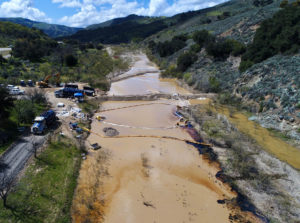
On Tuesday, March 8, Santa Barbara County Supervisors voted 3-2 to deny ExxonMobil’s proposal to send up to 78 oil trucks per day, over 24,800 per year, onto already crowded and dangerous highways.
The proposed route— from ExxonMobil’s Las Flores Canyon pump station in Gaviota to Santa Maria along Highway 101 and then to Mariposa along State Route 166—would have passed over and along the Cuyama River and Twitchell Reservoir, through Los Padres National Forest, and along the borders of Carrizo Plains Ecological Reserve, Carrizo Plain National Monument, and proposed wilderness included in a bill that has passed the House and is currently before the Senate. These public lands provide critical habitat for threatened or endangered species including southern California steelhead, California tiger salamander, arroyo toad, California condor, giant kangaroo rat, San Joaquin kit fox, mountain lion, California red-legged frog, and others.
Trucking is one of the most dangerous forms of oil transportation. Tanker trucks spill hundreds of thousands of gallons per year which can kill wildlife and contaminate soil and water. Spilled oil lingers in the environment for years and can continue harming wildlife and water quality long after cleanup teams have finished their work. Oil tankers also cause fires and explosions and often involved in deadly traffic accidents.

According to California Highway Patrol, there have been 258 oil trucking accidents in just six years on Exxon’s proposed route resulting in 10 deaths and 110 injuries. As recently as March of 2020, a tanker truck crashed on Rte. 166 spilling more than 4,530 gallons of oil into the Cuyama River near the Los Padres National Forest. Over 21 birds, fish, and frogs including two federally-protected California red-legged frogs were collected dead from the spill area or had to be cleaned of oil and treated by veterinarians.
The spill required the response of approximately 80 people during a peak in the COVID pandemic. Oil skimming equipment and vacuum trucks were needed to remove oil up to 2 miles downstream of the crash site. Rocks had to be cleaned by hand and underflow dams were constructed across the river to contain the spill, causing further damage to aquatic habitat.

If ExxonMobil had been granted the permit, three aging offshore drilling platforms in the Santa Barbara Channel would have been restarted for the first time since the 2015 Plains Pipeline oil spill. An inspection report published that same year—before the platforms sat dormant for seven years—found corrosion, electrical issues, and numerous components out of compliance.
Contrary to multiple claims by the oil industry, it is not possible to buy locally produced gas in Santa Barbara County. The decision will also not impact local gas prices or supplies. Oil drilled in Santa Barbara County is transported to refineries in Los Angeles and San Francisco and traded on the global market. The US west coast now exports 35 times more oil and petroleum products than what this project would produce.
According to the United Nations 6th IPCC Assessment Report, unless massive and immediate cuts in greenhouse gasses are made, the youngest of us, our children, and future generations will inherit a planet experiencing devastating and irreversible climate change with mass extinctions, vector-borne disease and pandemics, and increasingly severe weather-driven events such as wildfires and hurricanes.
The decision was the result of years of community engagement and collaboration by organizations that include Los Padres ForestWatch, 350 Santa Barbara, California Coastal Protection Network, California Wildlife Foundation/California Oaks, CalTrout, Carpinteria Valley Association, Center for Biological Diversity, the Center for Oceanic Awareness Research, and Education (COARE), Channel Islands Restoration, Citizens Planning Association, Climate First: Replacing Oil and Gas, the Coastal Band of the Chumash Nation, Coastal Ranches Conservancy, Community Environmental Council, the Cuyama Valley Community Association, Eco Vista, Environmental Center of San Luis Obispo, Environmental Defense Center, Explore Ecology, Food & Water Watch, Food and Water Action, Fund for Santa Barbara, Gaviota Coast Conservancy, Get Oil Out!, Goleta Goodland Coalition, Goodland Coalition, Heal the Bay, Heal the Ocean, the League of Women Voters (Santa Barbara), Northern California Recycling Association, the Plastic Pollution Coalition, Plastics Ocean International, Santa Barbara Audubon, Santa Barbara Channelkeeper, Santa Barbara County Action Network, the Santa Barbara Standing Rock Coalition, the Santa Barbara Urban Creeks Council, Save Our Shores, the SB Museum of Natural History & Sea Ctr, Seventh Generation Advisors, Sierra Club Los Padres Chapter, Sierra Club Santa Lucia Chapter, Society of Fearless Grandmothers (SB), Surfrider Foundation, Surfrider Foundation Santa Barbara County Chapter, The 5 Gyres Institute, UCSB Associated Students External Vice President for Statewide Affairs Esmeralda Quintero-Cubillan, UCSB Coastal Fund, UCSB Environmental Affairs Board, UCSB Environmental Justice Alliance, UPSTREAM, WE Watch, Wishtoyo Chumash Foundation, and Zero Waste USA.







Comments are closed.